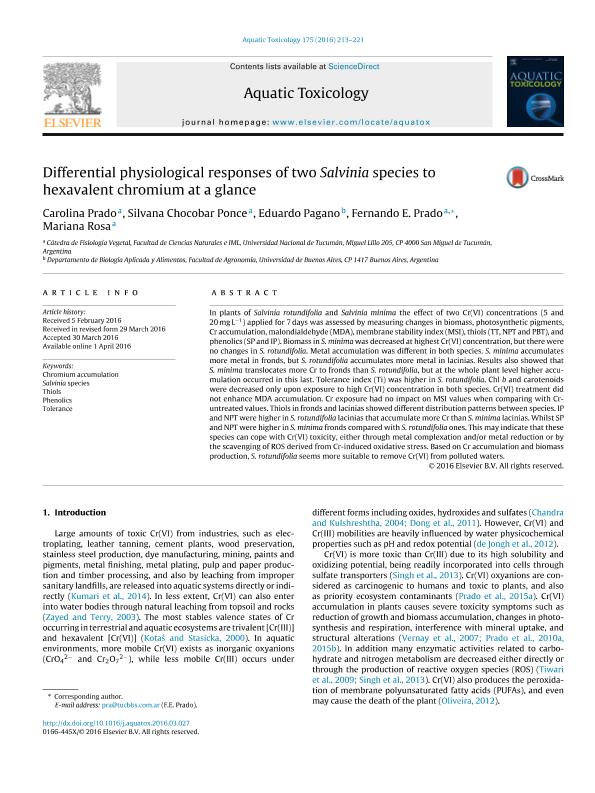Mostrar el registro sencillo del ítem
dc.contributor.author
Prado, Carolina del Valle

dc.contributor.author
Chocobar Ponce, Silvana

dc.contributor.author
Pagano, Eduardo Antonio

dc.contributor.author
Prado, Carolina del Valle

dc.contributor.author
Rosa, Mariana Daniela

dc.date.available
2018-09-03T15:38:17Z
dc.date.issued
2016-06
dc.identifier.citation
Prado, Carolina del Valle; Chocobar Ponce, Silvana; Pagano, Eduardo Antonio; Prado, Carolina del Valle; Rosa, Mariana Daniela; Differential physiological responses of two Salvinia species to hexavalent chromium at a glance; Elsevier Science; Aquatic Toxicology; 175; 6-2016; 213-221
dc.identifier.issn
0166-445X
dc.identifier.uri
http://hdl.handle.net/11336/58059
dc.description.abstract
In plants of Salvinia rotundifolia and Salvinia minima the effect of two Cr(VI) concentrations (5 and 20 mg L-1) applied for 7 days was assessed by measuring changes in biomass, photosynthetic pigments, Cr accumulation, malondialdehyde (MDA), membrane stability index (MSI), thiols (TT, NPT and PBT), and phenolics (SP and IP). Biomass in S. minima was decreased at highest Cr(VI) concentration, but there were no changes in S. rotundifolia. Metal accumulation was different in both species. S. minima accumulates more metal in fronds, but S. rotundifolia accumulates more metal in lacinias. Results also showed that S. minima translocates more Cr to fronds than S. rotundifolia, but at the whole plant level higher accumulation occurred in this last. Tolerance index (Ti) was higher in S. rotundifolia. Chl b and carotenoids were decreased only upon exposure to high Cr(VI) concentration in both species. Cr(VI) treatment did not enhance MDA accumulation. Cr exposure had no impact on MSI values when comparing with Cr-untreated values. Thiols in fronds and lacinias showed different distribution patterns between species. IP and NPT were higher in S. rotundifolia lacinias that accumulate more Cr than S. minima lacinias. Whilst SP and NPT were higher in S. minima fronds compared with S. rotundifolia ones. This may indicate that these species can cope with Cr(VI) toxicity, either through metal complexation and/or metal reduction or by the scavenging of ROS derived from Cr-induced oxidative stress. Based on Cr accumulation and biomass production, S. rotundifolia seems more suitable to remove Cr(VI) from polluted waters.
dc.format
application/pdf
dc.language.iso
eng
dc.publisher
Elsevier Science

dc.rights
info:eu-repo/semantics/openAccess
dc.rights.uri
https://creativecommons.org/licenses/by-nc-sa/2.5/ar/
dc.subject
Chromium Accumulation
dc.subject
Phenolics
dc.subject
Salvinia Species
dc.subject
Thiols
dc.subject
Tolerance
dc.subject.classification
Otras Ciencias Biológicas

dc.subject.classification
Ciencias Biológicas

dc.subject.classification
CIENCIAS NATURALES Y EXACTAS

dc.title
Differential physiological responses of two Salvinia species to hexavalent chromium at a glance
dc.type
info:eu-repo/semantics/article
dc.type
info:ar-repo/semantics/artículo
dc.type
info:eu-repo/semantics/publishedVersion
dc.date.updated
2018-08-27T19:19:31Z
dc.journal.volume
175
dc.journal.pagination
213-221
dc.journal.pais
Países Bajos

dc.journal.ciudad
Amsterdam
dc.description.fil
Fil: Prado, Carolina del Valle. Consejo Nacional de Investigaciones Científicas y Técnicas. Centro Científico Tecnológico Conicet - Tucumán; Argentina. Universidad Nacional de Tucumán. Facultad de Ciencias Naturales e Instituto Miguel Lillo. Cátedra de Fisiología Vegetal; Argentina
dc.description.fil
Fil: Chocobar Ponce, Silvana. Consejo Nacional de Investigaciones Científicas y Técnicas. Centro Científico Tecnológico Conicet - Tucumán; Argentina. Universidad Nacional de Tucumán. Facultad de Ciencias Naturales e Instituto Miguel Lillo. Cátedra de Fisiología Vegetal; Argentina
dc.description.fil
Fil: Pagano, Eduardo Antonio. Universidad de Buenos Aires. Facultad de Agronomía. Departamento de Biología Aplicada y Alimentos; Argentina
dc.description.fil
Fil: Prado, Carolina del Valle. Consejo Nacional de Investigaciones Científicas y Técnicas. Centro Científico Tecnológico Conicet - Tucumán; Argentina. Universidad Nacional de Tucumán. Facultad de Ciencias Naturales e Instituto Miguel Lillo. Cátedra de Fisiología Vegetal; Argentina
dc.description.fil
Fil: Rosa, Mariana Daniela. Consejo Nacional de Investigaciones Científicas y Técnicas. Centro Científico Tecnológico Conicet - Tucumán; Argentina. Universidad Nacional de Tucumán. Facultad de Ciencias Naturales e Instituto Miguel Lillo. Cátedra de Fisiología Vegetal; Argentina
dc.journal.title
Aquatic Toxicology

dc.relation.alternativeid
info:eu-repo/semantics/altIdentifier/doi/http://dx.doi.org/10.1016/j.aquatox.2016.03.027
dc.relation.alternativeid
info:eu-repo/semantics/altIdentifier/url/https://www.sciencedirect.com/science/article/pii/S0166445X16300893
Archivos asociados
